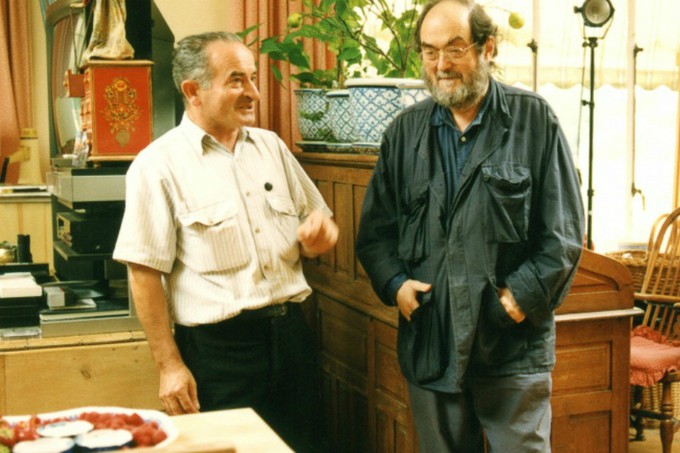
S IS FOR STANLEY (2016), dir. Alex Infascelli
Upon walking into the legendary, gorgeous Egyptian here in Hollywood for my first Beyond Fest screening of 2016, I brushed shoulders with a bearded, young-looking guy I immediately recognized as Brett Ratner. Seeing as the two movies being screened at that time were PHANTASM V and this documentary, I was definitely wondering what the hell the Ratt was doing spending his Saturday night at this particular movie theater. Much to my surprise, he was there to introduce this film and its director, whom I placed as part of the entourage he walked in with. Now, he had to have known that his recognizable image doesn’t necessarily inspire images of the highest forms of cinema to the filmphiles attending Beyond Fest that night, but he also probably (correctly) surmised that being there in person to introduce this doc (which he produced through his production company, RatPac) would instantly give it a boost in terms of publicity and in terms of our expectations of its effectiveness as an enjoyable, digestible entertainment. It’s not like he’d be there to say a few words about the four-hour version of HAMLET or something.
He did emphasize that the film wasn’t a straightforward doc about Kubrick, but rather a view of the director through the eyes of one of his closest confidantes: his chauffeur of 25 years, Emilio D’Alessandro. This film is nearly entirely comprised of one-on-one interviews with D’Alessandro and his wife, Janette, in their home in Italy, as they tell the story of their relationship with Kubrick, starting around the time of A CLOCKWORK ORANGE and extending to his death in 1999.
D’Alessandro is a modest, heavily-accented man who started out as an aspiring Formula One driver before crossing paths with the already-famous director. He was working as a cab driver when he received a large white sculpture with a very specific shape (which, apparently, was hard to squeeze into a trunk), along with instructions to deliver it to the set of CLOCKWORK outside his adopted home of London. Impressed with his speed behind the wheel, Kubrick hired him as his personal chauffeur, but their increasingly close relationship matched with Kubrick’s oddball, meticulous demands led to him functioning more as a personal assistant than anything else. There’s a lot of pathos and laughs in the sometimes typed, sometimes handwritten memos from Kubrick to D’Alessandro, as he asks for things as varied as equipment deliveries to his sets, whiskey (preferably Haig) to his editing room, and the status of his family. As the years go by, the two become very good chums, and we are able to see one of the greatest filmmakers, perhaps one of the greatest artists of the 20th century, in the perspective of someone who thought of him not as a genius, but as a friend…albeit a friend who landed him in the company of Jack Nicholson and Tom Cruise.
While both Ratner and the director noted that the film wasn’t really a film “about” Kubrick as a director, the presence of his work looms over every musing and anecdote relayed to us by D’Alessandro over the course of the runtime. We wait patiently as his story hops between the films Kubrick made during their time together (CLOCKWORK, BARRY LYNDON, THE SHINING, FULL METAL JACKET, and EYES WIDE SHUT), and are awarded with some great stories from those sets, along with peeks at D’Alessandro’s considerable number of mementos. We catch glimpses of reels that Kubrick shot to test the natural lighting techniques used in LYNDON. We hear about what it was like to drive Nicholson around London circa ’79, as he freely snorts coke, rolls joints, and hits on young girls on the street. We see both D’Alessandro and his wife shoot cameos for EYES WIDE SHUT, along with their respective stories of their time on that infamous set. Director Infascelli maintained that he did not want to use archive footage, as they’d likely distract from the intimacy (“and besides,” he reflected, “you just have to hear ‘Paul McCartney plays ‘Let It Be,’ and you know what it sounds like. You don’t have to actually hear ‘Let It Be.’”), but they, and Kubrick’s undeniable genius, are the subtext that permeates every frame, even when the focus is strictly on their personal lives or their friendship.
Some might complain that without the archive footage, the film is essentially a talking head interview with an old guy in his garage, punctuated with scenes of his wife, written memos from “S”, and still photographs. I found the laser focus brave and inspiring, with the director choosing to paint the canvas primarily with D’Alessandro’s character-rife face and slow, friendly dialect, with him and the camera functioning in tandem as the storyteller. In fact, I’d say a big misstep Infascelli makes is his decision to include various location shots of D’Alessandro out of his chair, including recreations, sullen walking, and even a visit to the Kubrick compound, Childwickbury (or “Childwick” for short). They feel phony and entirely unnecessary; the former driver’s words and souvenirs evoke more movement and adventure than any forced attempts to inject scope, and I mean it when I say I could listen to the full six hours worth of interviews Infascelli allegedly conducted to get a better sense of D’Alessandro, both regarding his relationship with Kubrick and his own experience as a man.
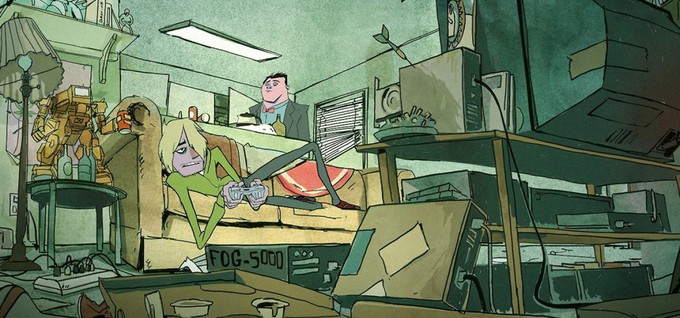
NERDLAND (2016), dir. Chris Prynoski
It’s a good time for adult animation. SAUSAGE PARTY, and it’s current $125 million worldwide gross, have proved that there’s an international market for adult-themed animated movies, provided they’re colorful, star-studded, and silly. Despite my love for that film, it’s not lost on me that a lot of animation fans were disappointed, hoping for something more along the lines of Ralph Bakshi’s subversive, artsy work.
That’s why we need movies like NERDLAND.
Now I’m not going to sit here and claim NERDLAND is a masterpiece, worthy of the collected talents of Titmouse Animation’s Prynoski, screenwriter Andrew Kevin Walker (yes, that Andrew Kevin Walker), and cast members Paul Rudd, Patton Oswalt, Kate Micucci, Riki Lindhome, Hannibal Burress, Paul Scheer, Brendan Small, and Mike Judge…I mean, what could be? But there’s something honest, angry, and likable about Walker’s story of two 30-year-old slackers trying to make it big in La-La-Land that makes up for the episodic plotting and the somewhat threadbare characterizations. It has the irreverence and low-fi animation of the Adult Swim of yesteryear, but with a personal, human bent that makes it all feel a little sick and fucked up…in a good way.
John and Elliot are the only two unemployed 30ish creatives living together in L.A. while trying to break into the film industry. John (Rudd) is a big and stocky aspiring actor, but can’t keep his chocolate starfish in his boxers long enough to book a gig. Skinny, scrawny Elliot wants to be a working screenwriter, but can’t put down the bong, shave his scraggle, or refrain from writing about a modern Rip Van Winkle update where he goes on a murderous rampage. The two want desperately to “make it” and be famous, but lack the aptitude, the connections, and the general sense of sanity to do it on merit, so John lands on a big idea: a real-life killing spree. After all, infamy’s the name of the game these days, right? The two set out to carve their names in the stars using the blood of their fallen victims, but of course, they fuck that up too, and before you know it, there’s a whirlwind of attention falling on them, and they have to navigate their newfound fame/infamy without ending up dead, in jail, or at the very least, irredeemably disgraced.
Walker explained that on the path to getting this made, which included an aborted live-action version directed by Walker’s SE7EN collaborator David Fincher, one of the forms the story took was as 5-minute webisodes. There doesn’t seem to have been a lot of rewriting since that stage; the film really does feel like a collection of individual sketches, and the plotting is so loose and perfunctory that the narrative never really gels together in a satisfying way. Let’s just say that between SE7EN, SLEEPY HOLLOW, and NERDLAND, this film is easily the least coherent, and the constant shuffling between tangents in lieu of momentum or actual characterizations makes the final product somewhat less than totally satisfying.
That’s a shame, because the movie is really quite funny. Rudd and Oswalt recorded their lines apart, on Skype, but their characters dominate the film, and the chemistry between Elliot and John is very much there. The dynamic between the somewhat dim, steadfast John and the squirrely, angsty Elliot is enough to liven up their adventures singlehandedly, which is good because there’s nothing else going on in the story to back them up. I’m sure the joke was not lost on Rudd and Oswalt that the skinnier guy plays bulky John while chubby Patton plays Cobain-y Elliot, but there were times I forgot that those instantly recognizable voices were those guys and not the characters. Their names are probably the biggest appeal of this film, and their characters really are the backbone of the film. Some of the voice cameos are more memorable than others, like Buress’ Jabba-like ubergeek svengali and Brendan Small’s miserable, onesied boutique manager, while Miccucci and Lindhome (also known as Garfunkel and Oates) are funny as the vapid, parasitic objects of John and Elliot’s respective affections. Still, despite the massive voice cast, it’s really Rudd and Oswalt’s comic talents keeping you interested as the plot bounces them from one possible catastrophe to the next.
That’s not to say Walker’s script isn’t packed to the gills with funny shit, specifically in its portrayal of Hollywood through the eyes of two angry young men struggling with their contempt for the entertainment industry. Elliot plays a game titled something along the lines of “Evil Kill,” John crosses paths with a vapid, scarfed action star, and advertisements for his latest, ridiculous looking thriller pepper the billboards, bus stops, and even the escalators of the city. There’s a running joke about the Hollywood sign being renovated into something bigger, sexier, and even more self-congratulatory, and the portrayal of a fickle, cuckoo-bananas media cycle is sharp and funny, if a little well-worn. There are a handful of hilarious references to Walker’s own SE7EN, both conceptually (Elliot’s Rip Van Winkle riff feels a lot like John Doe’s journey) and visually (John’s plan involves them turning themselves in exactly the same way as Spacey in that film). More than anything, the script feels intensely personal; Walker allegedly based Elliot and John on himself and his longtime roommate/partner, and while they feel more off-putting and rough around the edges than your typical leading men, they are 100% relatable. They feel real enough that when they start doing outlandish stuff, like plotting a murder spree or assaulting an old lady, it doesn’t shatter the reality (or whatever semblance of reality that’s there) because you understand their perspective. Every other character is a cartoon (yes, literally, but also figuratively), but Elliot and John provide a great vehicle for Walker to voice his own anti-showbiz sentiments, all while telling a version of his own story as a pre-success in the industry.
This doesn’t have the breakneck anarchy of the last theatrical feature by Adult Swim animators, AQUA TEEN HUNGER FORCE MOVIE FILM FOR THEATERS, or the pointed focus of SAUSAGE PARTY, and it seems fairly insular in terms of being about and for those familiar with the realities of those struggling to make it in the City of Angels (though I heard the film played well at Tribeca in NYC, so I could be wrong). But the minimalist animation, the excellent lead performances by Rudd and Oswalt, and Walker’s personality and evident passion for the material give it a distinctive vibe, and the jokes that work come at a frequent enough pace that I never succumbed to boredom or indifference. In a perfect world, there would absolutely be a market for this, other Adult Swim productions, and even Bakshi’s latter day work, but until the Powers That Be perceive of (or create) one, we’ll hopefully continue to get memorable little oddities like this in between ICE AGE and KUNG FU PANDA sequels.
Still don’t really get the title though. They’re not really huge nerds, and neither is the vast majority of those they encounter. Maybe it will come to me later.
During the introduction for night 3’s double feature, Christian Parkes, one of the masterminds behind Beyond Fest, mentioned that ASH VS. EVIL DEAD was one of the sponsors for the festival, and that it was a shame that we wouldn’t be able to catch the Season 2 premiere live when it aired on Starz that night. A few folks in the crowd boo-ed, obviously unaware of the setup, and then you heard a familiar, snake-charming voice bellow from the back, “Boo is right!”
Sure enough, out comes Sir Bruce L. Campbell, esq., in all his mega-chinned glory, looking dapper as ever in a sharp suit complete with handkerchief, already charming the pants off the crowd before the glint can reflect off of his pearly whites. He lays down a quick intro, that went a little something like this:
”Some of you may not be prepared for what you are about to see. We call it ‘splatstick.’ A little horror, a little comedy. Come for the horror, stay for the comedy. Come for the comedy, stay for the horror. Whatever your preference is. Does anyone have any questions about what they are about to see?”
Then, leaving as quickly as he came, Mr. Campbell ascended back into the heavens, and we saw the Season 2 premiere that many of you have already seen. My quick thoughts; it was a great episode, one that had apparently learned from some of the tonal and pacing issues of the first season, with more than one killer Ash one-liner and great uses for the returning cast, plus the hilarious rendezvous with Ash’s daddy, incarnated by Lee Majors (he, and the “better, stronger, faster” reference, were both well-received by the audience) Pablo’s recurring nightmare about his face and the Necromomicon still freaks me out, and I like the direction they’re going with Lucy Lawless’ character. The stakes definitely feel high now that Ash has a close-knit group and the world’s really starting to fall apart around them. Still riding high on the wave of energy that the series creates both by existing and actually living up to its potential.
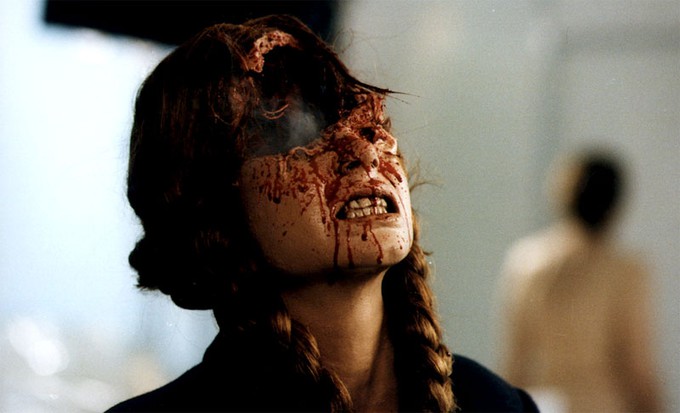
THE BEYOND (w/ live score by Fabio Frizzi) (1981), + CITY OF THE LIVING DEAD (1980), dir. Lucio Fulci
When I first watched THE BEYOND years ago, I was admittedly underwhelmed. It doesn’t have quite the rep of SUSPIRIA or ZOMBIE, but the consensus had set me up for one showstopping Italian horror flick, and I found myself disappointed in the threadbare plotting, unconvincing gore effects, and occasionally laughable characterizations. However, as I learn more and more on this runaway train that is life, context is everything, and seeing it with at the legendary Egyptian with a sold-out crowd while accompanied by Fabio Frizzi and his band playing the score was quite a different experience to the one I had at 2 in the morning with my bedroom TV set.
Frizzi had a full band with him, including three guitarists (he would noodle away himself on a couple of tracks), a lead synthesizer, a drummer with a full kit, and one mega-impressive female vocalist. The presentation was dubbed “The Composer’s Cut,” but it seemed full-length, and I’m certainly not familiar enough with the film to have noticed any smaller changes in the edit. Besides, the film already seemed incoherent to me, so the fact that it didn’t make a lick of sense didn’t make me think they took the scissors to it. It wasn’t like there was wall-to-wall music; the dialogue and effects were played at full volume, and there were long stretches where we were just sitting there watching a gorgeous scan of the film, which made the musical punctuations by Frizzi & co. even more jarring than those cues already are.
The haunting, softer stuff was lovely, moody, and transcendant, but during the extreme gore moments, like the infamous spider death and the redheaded girl getting her head blown off, the bombast of the band mixed with the energy of the visuals made the place erupt like a rock concert. Occasionally, it almost seemed like they had forgotten there was a 7-8 piece band in the process of playing them music, considering how loud they’d be cheering over them after the set pieces. Based on the everlasting smile on Frizzi’s face, it’s tough to say that the noise got in his way, and I’m sure no one in his roster would’ve traded the energy in the room for all the peace and quiet in the universe.
After the film, Frizzi and his cronies played for about 30-40 minutes, occasionally dropping in an easily recognizable film theme but mostly just weaving in and out of various medleys. They seemed a lot more active during this section, at least in terms of movement; there was more rock beats and full-band music in the encores than in the vocal-and-piano-heavy BEYOND score, not to mention no film playing on the 50-foot screen behind them, so everyone seemed a lot more busy. They put on a hell of a show, laying down more than one toe-tapping funk line and staying on for what seemed like 3 full encores, never once outstaying their welcome. They closed with a medley from the Lamberto Bava movie DEVIL DISH (a.k.a. MONSTER SHARK), which showcased cues ranging from bass-heavy grooves to ‘80s-style power synths. They clearly relished the love coming off of the crowd, and their energy and ability was such that I’d gladly see them perform without the promise of a film playing alongside (or, more accurately, behind) them.
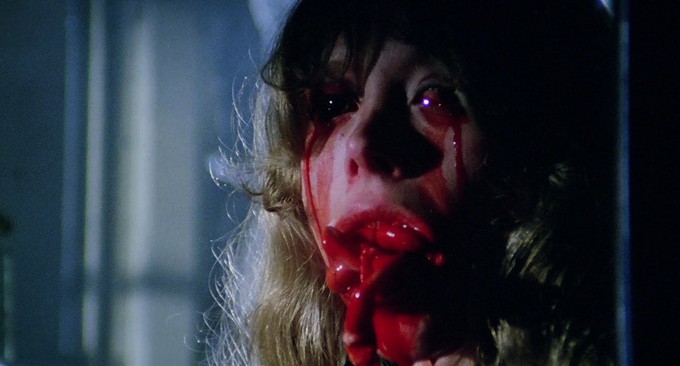
I went into CITY OF THE LIVING DEAD cold (wacka), though I’d meant to see it for years now. No musical accompaniment or even much by way of an introduction for this one, just an old, beat up 35mm print opening with the title “GATES OF HELL.” It’s arguably a stronger film storywise than THE BEYOND, with its parallel plotlines and multiple international locations (though much of the movie is setbound with only a few exteriors), but with less interesting and varied deaths and gore FX. There were definitely a handful of pretty ace, not-for-the-squeamish splatter moments, like the guy who gets his head slowly drilled through and the woman who wretches her own guts out (amazingly executed), but by the end, Fulci just starts repeating some of the more memorable gags, like women crying tears of blood and brains being ripped out from the back of characters’ heads. There’s just as much, if not more, spookiness derived from the imposing fog effects, or the way the evil priest, Father Thomas, is lit from underneath like a kid telling a scary story, making shadow art out of the angles of his face. There’s some hammy acting, particularly from Christopher George (ENTER THE NINJA) as the cigar-smoking reporter, but until the underwhelming last couple of deaths, it’s an effective, atmospheric flick, one that feels a lot more like IN THE MOUTH OF MADNESS than the nonsensical haunted house scares of THE BEYOND.
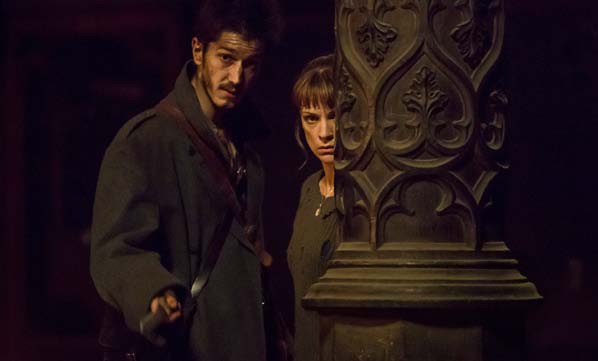
BEYOND THE WALLS (Au Dela des Murs) (2016), dir. Herve Hadmar
This French miniseries (which will be available in the U.S. exclusively through the horror-film streaming service, Shudder, starting October 20th) is three episodes long, and thankfully, they showed us all three back-to-back, making it feel more like a 100-minute-ish narrative than individual portions strung together. Experiencing it as a single entity, without waiting even 30 seconds for the next episode to start, it was a powerful, intense experience, easily one of the strongest supernatural horror films of recent memory, with an ideal cohesion between the subtext and text, the inner and external life of the main character, Lisa, and the existential and very practical threats she’s faced with.
Lisa (Veerle Baetens) lives alone in a small apartment in Paris. She’s a quiet homebody, and actively avoids social situations, using a fake wedding ring to deflect male attention. One day, she receives notice that an old man living across the street has been found dead in his living room armchair (30 years postmortem), and has bequeathed to her his rundown house. Finding it more to her liking than her tiny space, she quickly moves all of her stuff over despite the grim, dour surroundings, and finds herself in sympatico with the death and gloom lingering in the air Soon, she starts to hear something scurrying behind one of the walls, which she continues to strip until she breaks through the brick. Unable to pull away from the tantalizing force urging her in, she walks into the hole she’s created, leading to a hallway. Where it leads I wouldn’t dare to mention, except to say that Lisa can’t find her way back out, and that getting out will require her to face her demons, both literally and figuratively.
The setup that drives most of the first section is all insight into the character of Lisa, and with very little dialogue, we get to know who she is, how she operates, and even something of where she same from. It doesn’t really hint at the horrors to come, which pays off beautifully once she ventures beyond the titular walls; we’ve spent enough time with her in normal circumstances that we don’t need to be reminded of her problems or who she is as a person once the hit fits the shan. She just seems like a damaged, struggling young woman, not a character destined to plumb the bowels of hell like the women of THE DESCENT.
But once the show goes BEYOND THE WALLS, it grabs your nuts (or whatever you got) and never lets go, to the point where you’d hear breaths of relief every time the end credits signified the end of an episode. There’s some imagery that’s been done before, like creepy young girls fluttering away before you get a good look, humans with animal heads, and snarling creatures that look like Arnold after his LAST ACTION HERO tar bath, but it’s presented with a level of slow-burn dread that recalls SILENT HILL in its ambition to drag out the tension until you’re trapped by it, looking for escape just like the characters.
Perhaps the thing that could either annoy you or win you over is the directness of the title metaphor. We are dealing with a character who has put up walls in her life, for reasons we eventually learn, and her struggle to break through her self-imposed social exile and engage in meaningful human contact is very pertinent and relatable. Who hasn’t found themselves lying to strangers for no reason and opting out of happy hour to stay home and tap on the keyboard? What Lisa goes through beyond the portway in her house is very much connected to her emotional alienation, and there’s never a reasonable explanation for what we see other than possibly an extension of Lisa’s own psyche, which some horror aficionados could perceive as being very on-the-nose. I found it somewhat brilliant; I’ve seen many films bend over backwards to justify the external horror and bloodletting with a contrived character arc or vice versa, but the threats here are so wrapped up in the main character’s own fears that the whole thing feels like almost like a very intense, surreal character study.
Baetens is tasked with holding pretty much every scene and frame on her own, and her performance as Lisa needed to be rock solid for this thing to fly. Luckily, she cuts a striking figure, both cuddled away in the safety of her flat and covered in ash, the angles of her face as sharp as knives, ready to beat anything that steps to her with a steel fire-poker. There are very long stretches with no dialogue, and she constantly evokes personality, which is impressive considering her character is mostly struggling to survive in dark, imposing environments. There’s another character, named Julien (played with subtle charm by Francois Deblock), and the relationship between the two takes on a bizarre, but tangible intimacy; in a plotline somewhat reminiscent of Jemma’s story in the last season of AGENTS OF S.H.I.E.L.D., there’s is a kinship based on mutual fear and sympathy, and both actors expertly make that the emotional backbone of the miniseries. There’s a lot more emotion here than in most things this expertly horrifying, and I have to give DeBlock, Geraldine Chaplin (who pops up later, most creepily), and especially Baetens for helping to keep this thing feeling human at all times.
It’s hard to talk about a lot of the hyper-memorable imagery and surreal, nightmarish scares without giving anything away, but I will say that the Hadmar shows an expert touch at sustaining tension and making your skin crawl without reliance on jump scares. I honestly can’t think of one creepy moment that isn’t wholly earned, and even some of the cliched imagery is revealed to come from deeper, richer places than just the Horror Filmmakers Guide Book. Unlike a lot of horror that’s able to sustain its mood so successfully, it wraps up fairly neatly, and refuses to explain a lot of what goes down. While that makes it comes off somewhat slight once it all wraps up, the emotional journey of the characters is so expertly executed that it feels more like a complete, well thought out story with a clear, satisfying conclusion than something strictly designed for teenagers on dates. How many recent horror movies can you say that about?
